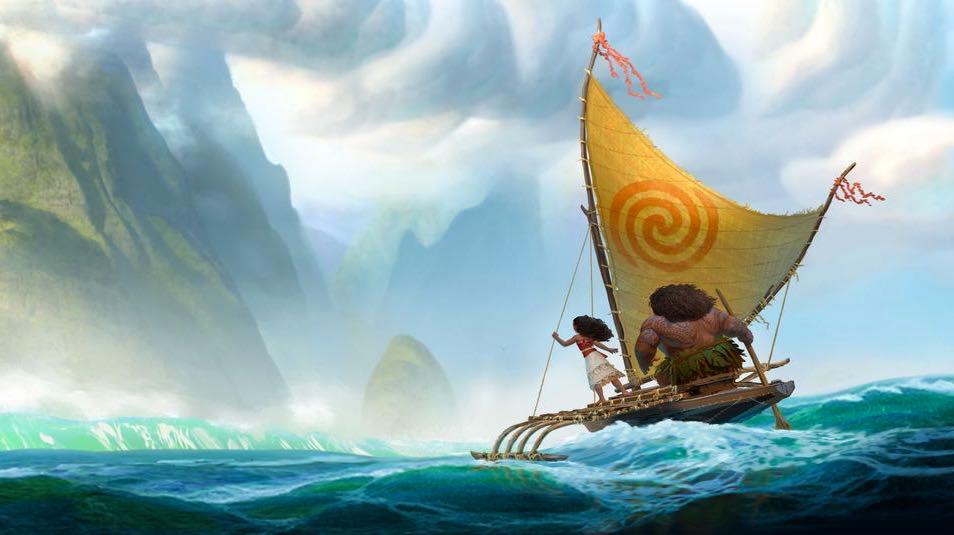Animating the friendly ocean in Disney’s ‘Moana’
This is a concept image from the Disney movie, "Moana."
Disney’s newest animated film “Moana” tells the story of a teenager who goes on a quest to save her people, leaving the safety of her home island in the South Pacific to travel the ocean.
Disney animators had the challenge of making all that water come alive, in more ways than one. Throughout the film, the water is, by turns, stormy, shallow and splashy. At one point, the water, personified here, even gives high-fives. Giving life to the ocean — which, in addition to acting like water, guides the heroine Moana in her journey — took more than a little imagination, as a couple of Disney animators can attest:
Marlon West, head of effects animation at Walt Disney Animation Studios, says that one challenge for “Moana” animators were the hundreds of “natural water shots” — shorelines, stormy seas, boat wakes and the like. Normally, a Disney film has just a few dozen water scenes, he says.
Another big hitch? Animating the ocean as an actual character in the film. “The things that we thought would make it look like natural water very often made the character feel maybe too aggressive or too wet — or not too wet, but you know, too agitated.”
Getting the friendly ocean figure just right was a group effort between West’s effects animators and the animation team, led by Amy Sneed, which handles character animation. Sneed’s team developed the ocean character’s performances, then shared them with effects animators for a dewy finish.
“It was a huge collaboration between our two departments,” Sneed says. “When the water was a character, we had a very rough rig, and it was similar to almost like a sock puppet. And we would animate the water, and then we would work with the effects animators, and they would make it actually look like water, with the bubbles and the water effects part of it.”
The animation in “Moana” was computer-generated (although the demigod Maui’s tiny moving tattoos were done the old-fashioned way, by hand). To make the water in “Moana” mimic real water behavior, Disney teams turned to high-tech animation programs.
“We have a lot of ‘water solvers’ that are … off the shelf, but we created one for this for this show called Splash,” West says, adding that the solver used “millions, in this case, very often billions, of particles” to simulate water in a natural way.
Even with the high-tech help, West says it took a few steps to make the ocean character look realistic. “We would do a simulation of water over [the] top of the animated character of the water,” he says. “And also, if you can imagine a Ziploc bag full of water — if you shook it, you have bubbles inside it. So we would add [those] as well.”
Lastly, West’s team stitched the ocean character back into the larger sea. “We all kind of agreed that the ocean would not have to duck its head back down or pull its arm back into the ocean,” West explains. Instead, animators decided to let the simulation take over after each performance — with the ocean character’s droplets simply falling back into the water.
“So you know, those are the kind of discussions and arguments grown-ups have in our building, like, ‘At what point does the ocean become a simulation again?’” he adds.
But beyond making the ocean character look "oceany," it had to have its own personality. Building emotion into the ocean character’s performances fell to Sneed’s team. And there, every movement mattered: “There's times when if you move the water up very slowly, that means something very different than if it rises very quickly,” she explains.
The ocean character wasn’t the only figure in the movie to stand out for its materiality. The animators say they also had fun creating the performance and effects for the lava monster Te Kā, who’s portrayed in the film as a volcano-like hulk.
“She’s huge,” Sneed says. “If she moves too quick, it doesn't look like she has weight to her, it doesn't look like she has the scale. And if she moves too slowly, then [she’s] not a real threat to Moana. So we did some tests, and then as animators came onto the film and started animating her, they were doing amazing things. And I love the way that she turned out.”
“We try to have truth in material as much as we can, even though our films are fantasies,” West adds. “So it was great that Te Kā, when she was angry, was dripping lava like a volcano — [which], when it’s really active, is the most fiery. And … she would cool off when she calmed down.”
When it comes down to it, the ocean in “Moana” is carefully crafted — and that means slowly, too. As Sneed explains, even with the help of computers, animated movies like “Moana” are made at a glacial pace.
“There's 24 frames per second,” Sneed says. “So with every one second, that's 24 drawings, or 24 poses — for us on CG films, they’re really poses that we're creating in the computer.”
“So it kind of gives you an idea that it's a time consuming — it's really fun — but it is a time-consuming process. We’ll animate a scene for, it’s probably three or four seconds in a week.”
This article is based on an interview that aired on PRI's Science Friday. To see what the water animation looked like at different stages of filming, head to Science Friday’s website.
